TAXATION LAW Assignment: Capital Gains, Fringe Benefits, Tax Evasion
VerifiedAdded on 2020/03/28
|12
|2581
|50
Homework Assignment
AI Summary
This taxation law assignment provides an in-depth analysis of various tax-related issues. The first question focuses on capital gains tax, examining the classification of assets (collectables, personal use, and ordinary business assets) and the implications for calculating gains and losses, including set-off and carry-forward rules. The second question addresses fringe benefit tax, specifically concerning a bank providing a loan to an executive at a lower-than-market interest rate, calculating the taxable fringe benefit and considering scenarios such as income-producing activities and loan repayment. The third question explores the allocation of profit or loss from a jointly owned house property, determining whether the allocation follows the ownership ratio or a formal agreement between the owners. The fourth question distinguishes between tax evasion and tax avoidance. The final question addresses the taxation of receipts from the sale of felled timber, considering whether such receipts are subject to income tax based on the nature of the activity and applicable legal principles. The assignment utilizes relevant tax legislation, rulings, and case law to support its conclusions.
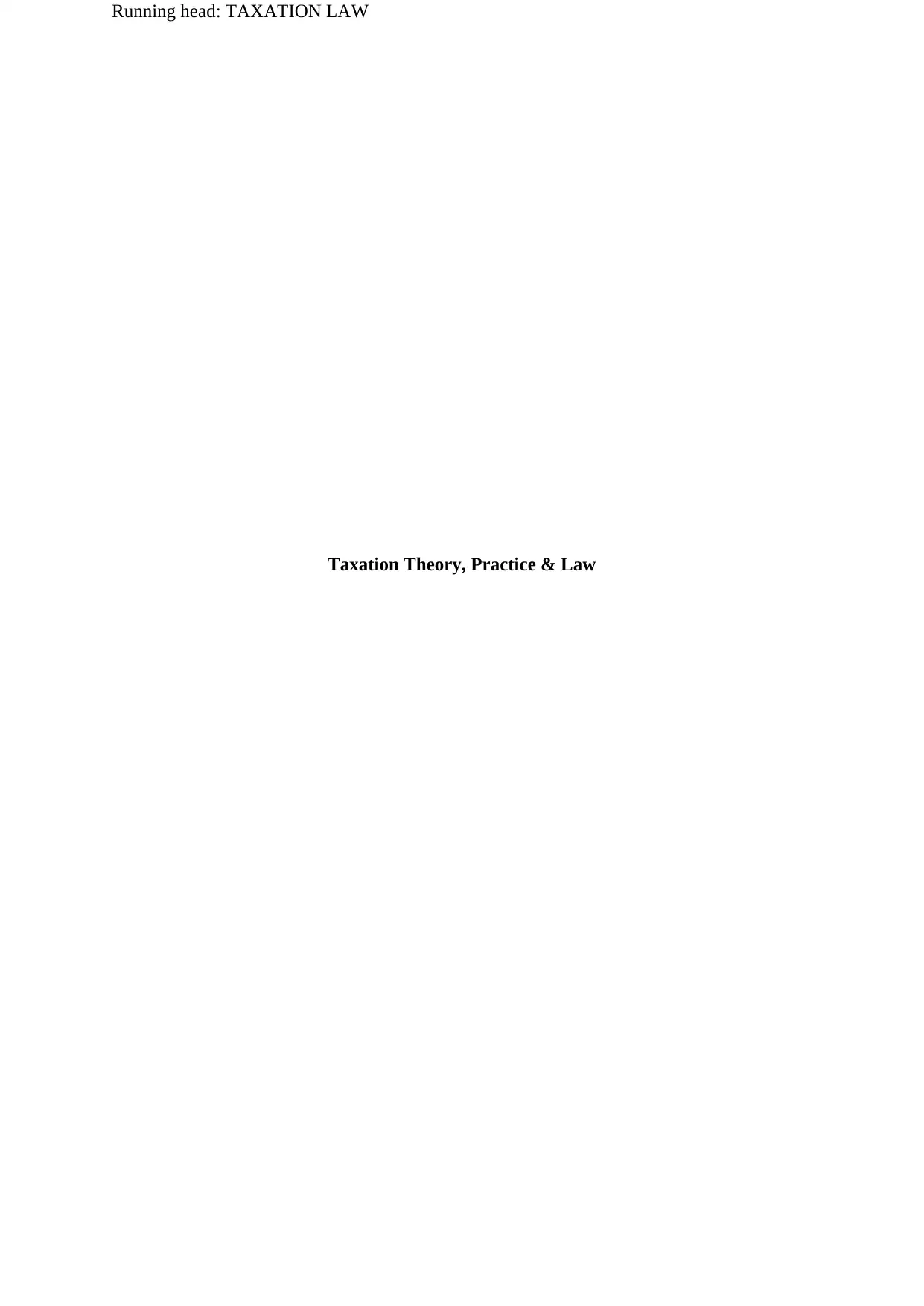
Running head: TAXATION LAW
Taxation Theory, Practice & Law
Taxation Theory, Practice & Law
Paraphrase This Document
Need a fresh take? Get an instant paraphrase of this document with our AI Paraphraser
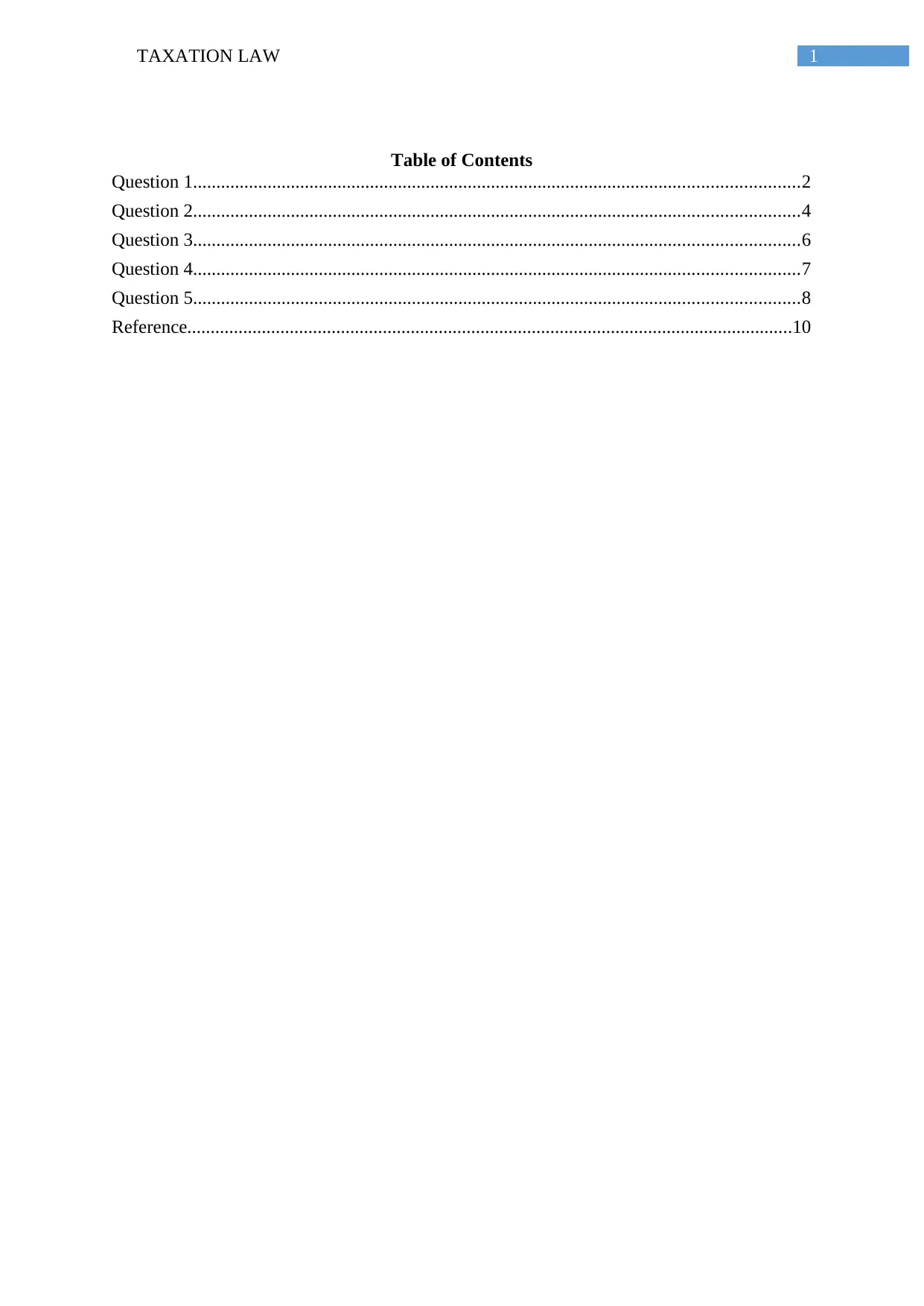
1TAXATION LAW
Table of Contents
Question 1..................................................................................................................................2
Question 2..................................................................................................................................4
Question 3..................................................................................................................................6
Question 4..................................................................................................................................7
Question 5..................................................................................................................................8
Reference..................................................................................................................................10
Table of Contents
Question 1..................................................................................................................................2
Question 2..................................................................................................................................4
Question 3..................................................................................................................................6
Question 4..................................................................................................................................7
Question 5..................................................................................................................................8
Reference..................................................................................................................................10
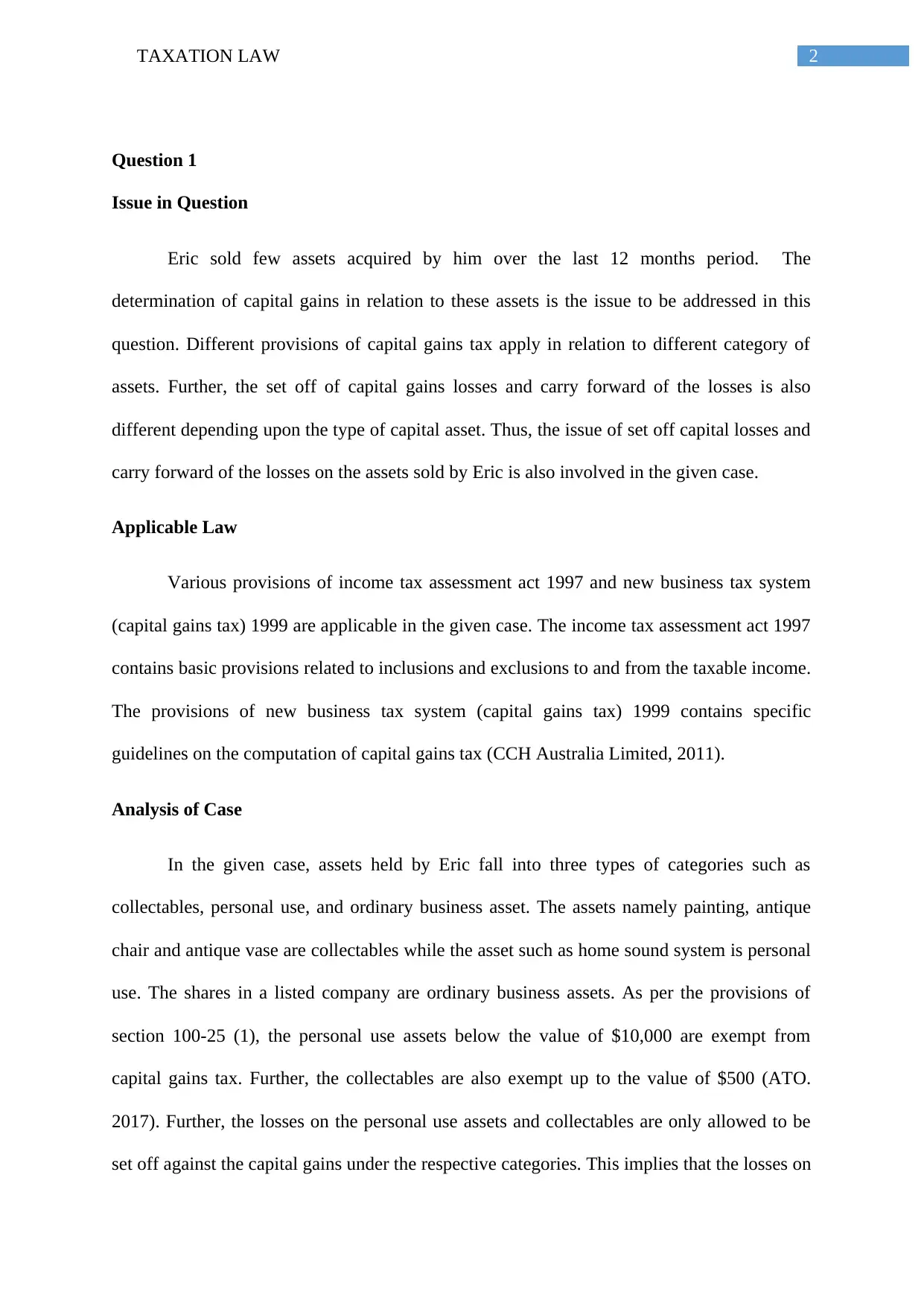
2TAXATION LAW
Question 1
Issue in Question
Eric sold few assets acquired by him over the last 12 months period. The
determination of capital gains in relation to these assets is the issue to be addressed in this
question. Different provisions of capital gains tax apply in relation to different category of
assets. Further, the set off of capital gains losses and carry forward of the losses is also
different depending upon the type of capital asset. Thus, the issue of set off capital losses and
carry forward of the losses on the assets sold by Eric is also involved in the given case.
Applicable Law
Various provisions of income tax assessment act 1997 and new business tax system
(capital gains tax) 1999 are applicable in the given case. The income tax assessment act 1997
contains basic provisions related to inclusions and exclusions to and from the taxable income.
The provisions of new business tax system (capital gains tax) 1999 contains specific
guidelines on the computation of capital gains tax (CCH Australia Limited, 2011).
Analysis of Case
In the given case, assets held by Eric fall into three types of categories such as
collectables, personal use, and ordinary business asset. The assets namely painting, antique
chair and antique vase are collectables while the asset such as home sound system is personal
use. The shares in a listed company are ordinary business assets. As per the provisions of
section 100-25 (1), the personal use assets below the value of $10,000 are exempt from
capital gains tax. Further, the collectables are also exempt up to the value of $500 (ATO.
2017). Further, the losses on the personal use assets and collectables are only allowed to be
set off against the capital gains under the respective categories. This implies that the losses on
Question 1
Issue in Question
Eric sold few assets acquired by him over the last 12 months period. The
determination of capital gains in relation to these assets is the issue to be addressed in this
question. Different provisions of capital gains tax apply in relation to different category of
assets. Further, the set off of capital gains losses and carry forward of the losses is also
different depending upon the type of capital asset. Thus, the issue of set off capital losses and
carry forward of the losses on the assets sold by Eric is also involved in the given case.
Applicable Law
Various provisions of income tax assessment act 1997 and new business tax system
(capital gains tax) 1999 are applicable in the given case. The income tax assessment act 1997
contains basic provisions related to inclusions and exclusions to and from the taxable income.
The provisions of new business tax system (capital gains tax) 1999 contains specific
guidelines on the computation of capital gains tax (CCH Australia Limited, 2011).
Analysis of Case
In the given case, assets held by Eric fall into three types of categories such as
collectables, personal use, and ordinary business asset. The assets namely painting, antique
chair and antique vase are collectables while the asset such as home sound system is personal
use. The shares in a listed company are ordinary business assets. As per the provisions of
section 100-25 (1), the personal use assets below the value of $10,000 are exempt from
capital gains tax. Further, the collectables are also exempt up to the value of $500 (ATO.
2017). Further, the losses on the personal use assets and collectables are only allowed to be
set off against the capital gains under the respective categories. This implies that the losses on
⊘ This is a preview!⊘
Do you want full access?
Subscribe today to unlock all pages.

Trusted by 1+ million students worldwide
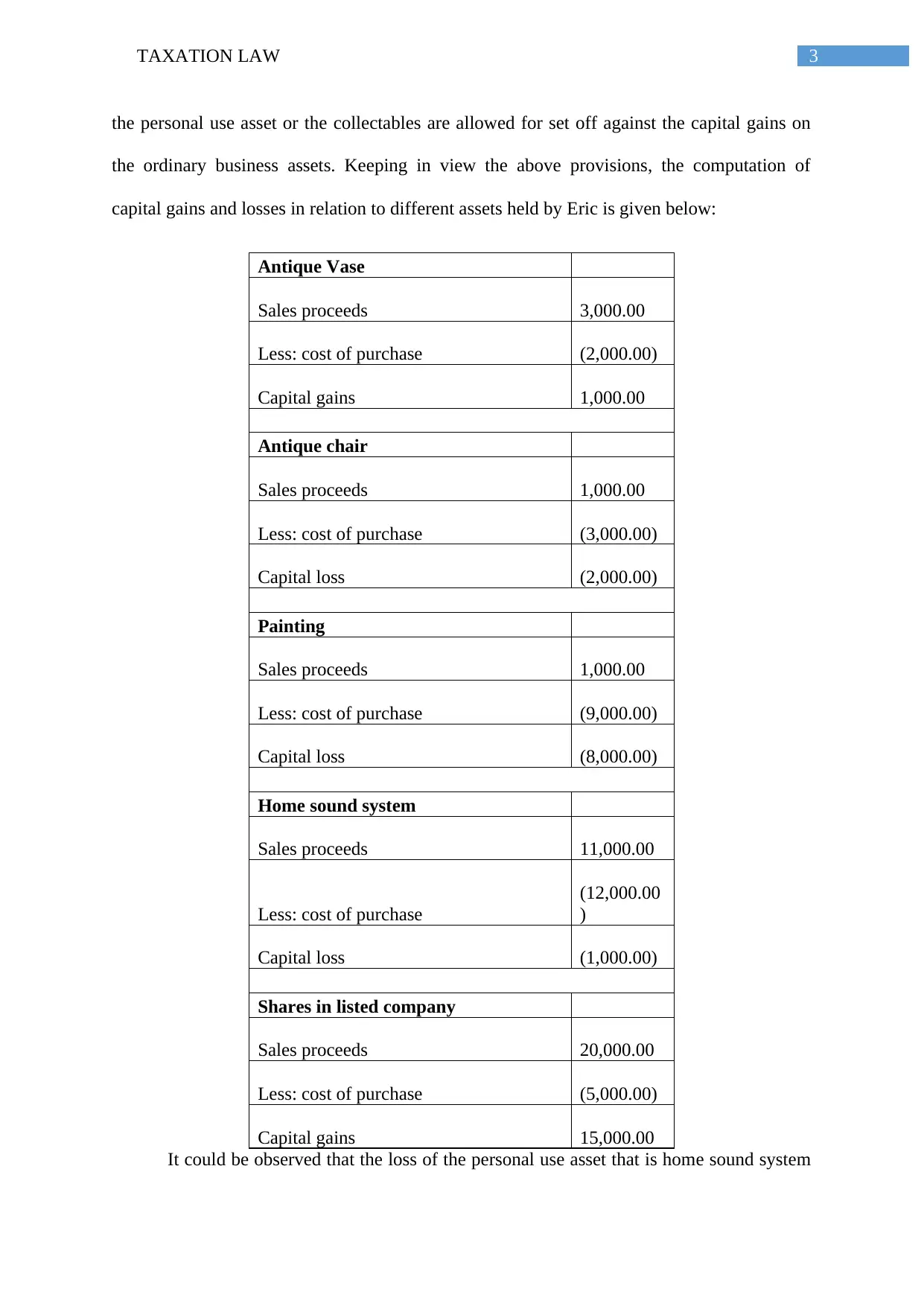
3TAXATION LAW
the personal use asset or the collectables are allowed for set off against the capital gains on
the ordinary business assets. Keeping in view the above provisions, the computation of
capital gains and losses in relation to different assets held by Eric is given below:
Antique Vase
Sales proceeds 3,000.00
Less: cost of purchase (2,000.00)
Capital gains 1,000.00
Antique chair
Sales proceeds 1,000.00
Less: cost of purchase (3,000.00)
Capital loss (2,000.00)
Painting
Sales proceeds 1,000.00
Less: cost of purchase (9,000.00)
Capital loss (8,000.00)
Home sound system
Sales proceeds 11,000.00
Less: cost of purchase
(12,000.00
)
Capital loss (1,000.00)
Shares in listed company
Sales proceeds 20,000.00
Less: cost of purchase (5,000.00)
Capital gains 15,000.00
It could be observed that the loss of the personal use asset that is home sound system
the personal use asset or the collectables are allowed for set off against the capital gains on
the ordinary business assets. Keeping in view the above provisions, the computation of
capital gains and losses in relation to different assets held by Eric is given below:
Antique Vase
Sales proceeds 3,000.00
Less: cost of purchase (2,000.00)
Capital gains 1,000.00
Antique chair
Sales proceeds 1,000.00
Less: cost of purchase (3,000.00)
Capital loss (2,000.00)
Painting
Sales proceeds 1,000.00
Less: cost of purchase (9,000.00)
Capital loss (8,000.00)
Home sound system
Sales proceeds 11,000.00
Less: cost of purchase
(12,000.00
)
Capital loss (1,000.00)
Shares in listed company
Sales proceeds 20,000.00
Less: cost of purchase (5,000.00)
Capital gains 15,000.00
It could be observed that the loss of the personal use asset that is home sound system
Paraphrase This Document
Need a fresh take? Get an instant paraphrase of this document with our AI Paraphraser
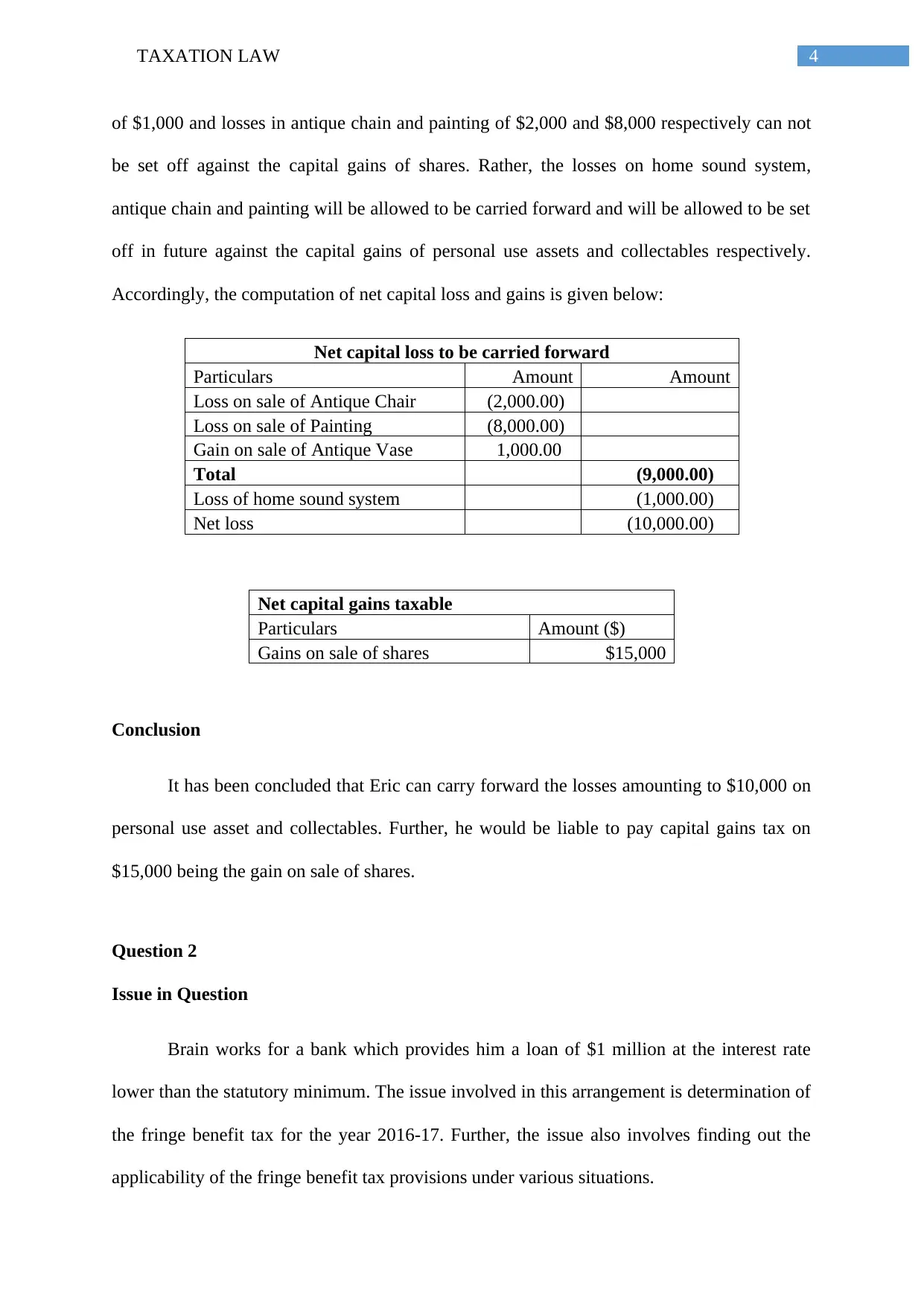
4TAXATION LAW
of $1,000 and losses in antique chain and painting of $2,000 and $8,000 respectively can not
be set off against the capital gains of shares. Rather, the losses on home sound system,
antique chain and painting will be allowed to be carried forward and will be allowed to be set
off in future against the capital gains of personal use assets and collectables respectively.
Accordingly, the computation of net capital loss and gains is given below:
Net capital loss to be carried forward
Particulars Amount Amount
Loss on sale of Antique Chair (2,000.00)
Loss on sale of Painting (8,000.00)
Gain on sale of Antique Vase 1,000.00
Total (9,000.00)
Loss of home sound system (1,000.00)
Net loss (10,000.00)
Net capital gains taxable
Particulars Amount ($)
Gains on sale of shares $15,000
Conclusion
It has been concluded that Eric can carry forward the losses amounting to $10,000 on
personal use asset and collectables. Further, he would be liable to pay capital gains tax on
$15,000 being the gain on sale of shares.
Question 2
Issue in Question
Brain works for a bank which provides him a loan of $1 million at the interest rate
lower than the statutory minimum. The issue involved in this arrangement is determination of
the fringe benefit tax for the year 2016-17. Further, the issue also involves finding out the
applicability of the fringe benefit tax provisions under various situations.
of $1,000 and losses in antique chain and painting of $2,000 and $8,000 respectively can not
be set off against the capital gains of shares. Rather, the losses on home sound system,
antique chain and painting will be allowed to be carried forward and will be allowed to be set
off in future against the capital gains of personal use assets and collectables respectively.
Accordingly, the computation of net capital loss and gains is given below:
Net capital loss to be carried forward
Particulars Amount Amount
Loss on sale of Antique Chair (2,000.00)
Loss on sale of Painting (8,000.00)
Gain on sale of Antique Vase 1,000.00
Total (9,000.00)
Loss of home sound system (1,000.00)
Net loss (10,000.00)
Net capital gains taxable
Particulars Amount ($)
Gains on sale of shares $15,000
Conclusion
It has been concluded that Eric can carry forward the losses amounting to $10,000 on
personal use asset and collectables. Further, he would be liable to pay capital gains tax on
$15,000 being the gain on sale of shares.
Question 2
Issue in Question
Brain works for a bank which provides him a loan of $1 million at the interest rate
lower than the statutory minimum. The issue involved in this arrangement is determination of
the fringe benefit tax for the year 2016-17. Further, the issue also involves finding out the
applicability of the fringe benefit tax provisions under various situations.
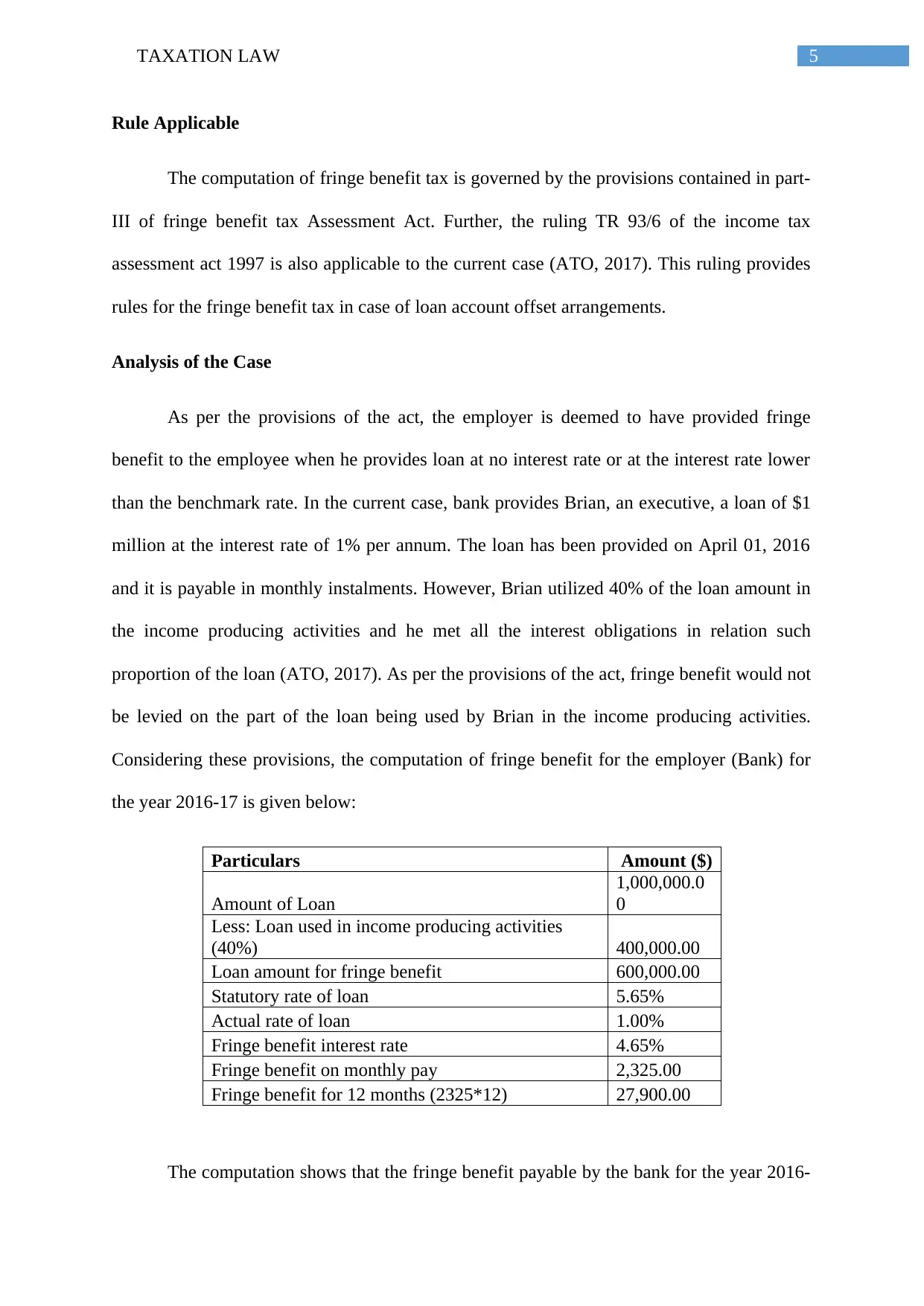
5TAXATION LAW
Rule Applicable
The computation of fringe benefit tax is governed by the provisions contained in part-
III of fringe benefit tax Assessment Act. Further, the ruling TR 93/6 of the income tax
assessment act 1997 is also applicable to the current case (ATO, 2017). This ruling provides
rules for the fringe benefit tax in case of loan account offset arrangements.
Analysis of the Case
As per the provisions of the act, the employer is deemed to have provided fringe
benefit to the employee when he provides loan at no interest rate or at the interest rate lower
than the benchmark rate. In the current case, bank provides Brian, an executive, a loan of $1
million at the interest rate of 1% per annum. The loan has been provided on April 01, 2016
and it is payable in monthly instalments. However, Brian utilized 40% of the loan amount in
the income producing activities and he met all the interest obligations in relation such
proportion of the loan (ATO, 2017). As per the provisions of the act, fringe benefit would not
be levied on the part of the loan being used by Brian in the income producing activities.
Considering these provisions, the computation of fringe benefit for the employer (Bank) for
the year 2016-17 is given below:
Particulars Amount ($)
Amount of Loan
1,000,000.0
0
Less: Loan used in income producing activities
(40%) 400,000.00
Loan amount for fringe benefit 600,000.00
Statutory rate of loan 5.65%
Actual rate of loan 1.00%
Fringe benefit interest rate 4.65%
Fringe benefit on monthly pay 2,325.00
Fringe benefit for 12 months (2325*12) 27,900.00
The computation shows that the fringe benefit payable by the bank for the year 2016-
Rule Applicable
The computation of fringe benefit tax is governed by the provisions contained in part-
III of fringe benefit tax Assessment Act. Further, the ruling TR 93/6 of the income tax
assessment act 1997 is also applicable to the current case (ATO, 2017). This ruling provides
rules for the fringe benefit tax in case of loan account offset arrangements.
Analysis of the Case
As per the provisions of the act, the employer is deemed to have provided fringe
benefit to the employee when he provides loan at no interest rate or at the interest rate lower
than the benchmark rate. In the current case, bank provides Brian, an executive, a loan of $1
million at the interest rate of 1% per annum. The loan has been provided on April 01, 2016
and it is payable in monthly instalments. However, Brian utilized 40% of the loan amount in
the income producing activities and he met all the interest obligations in relation such
proportion of the loan (ATO, 2017). As per the provisions of the act, fringe benefit would not
be levied on the part of the loan being used by Brian in the income producing activities.
Considering these provisions, the computation of fringe benefit for the employer (Bank) for
the year 2016-17 is given below:
Particulars Amount ($)
Amount of Loan
1,000,000.0
0
Less: Loan used in income producing activities
(40%) 400,000.00
Loan amount for fringe benefit 600,000.00
Statutory rate of loan 5.65%
Actual rate of loan 1.00%
Fringe benefit interest rate 4.65%
Fringe benefit on monthly pay 2,325.00
Fringe benefit for 12 months (2325*12) 27,900.00
The computation shows that the fringe benefit payable by the bank for the year 2016-
⊘ This is a preview!⊘
Do you want full access?
Subscribe today to unlock all pages.

Trusted by 1+ million students worldwide
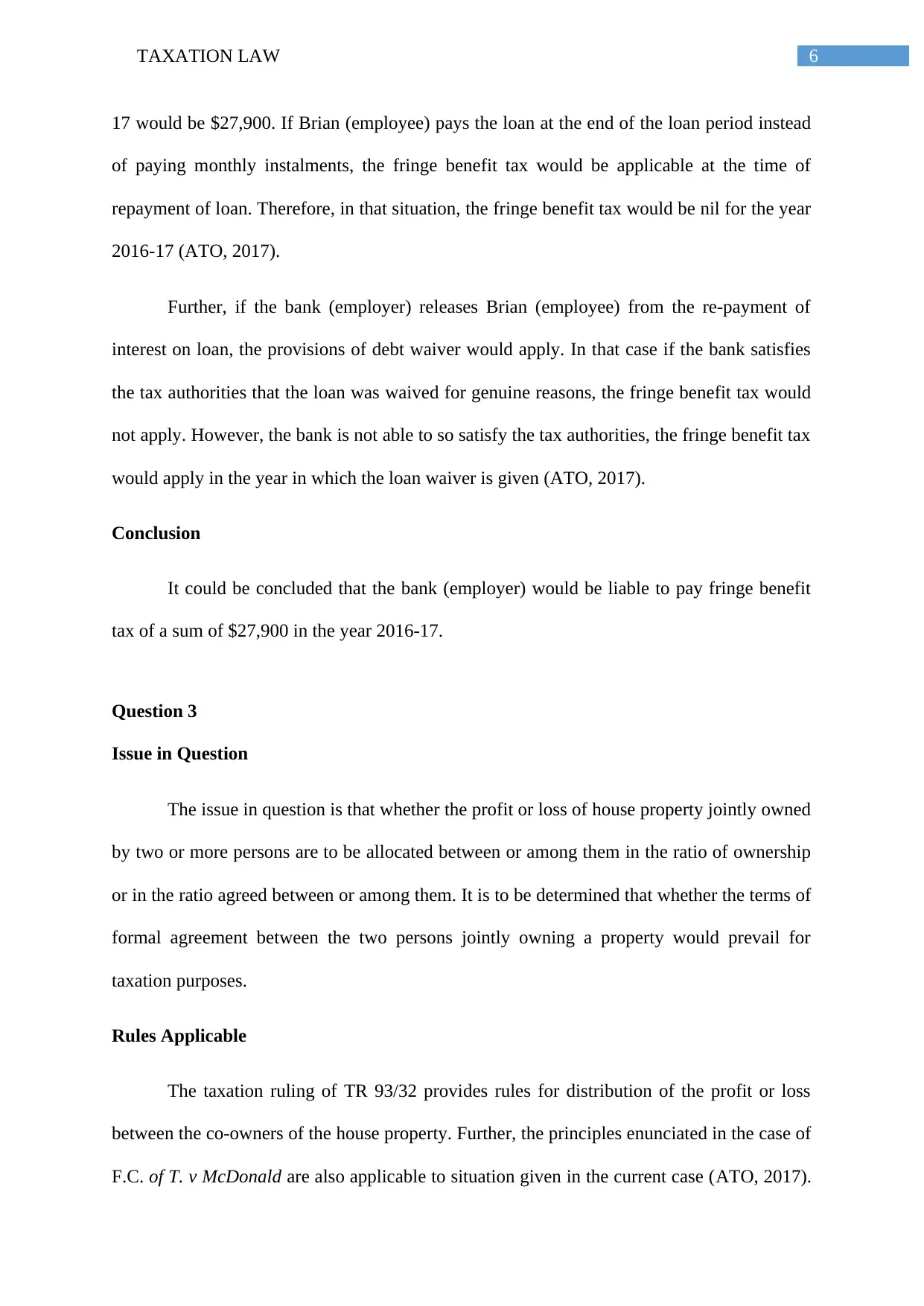
6TAXATION LAW
17 would be $27,900. If Brian (employee) pays the loan at the end of the loan period instead
of paying monthly instalments, the fringe benefit tax would be applicable at the time of
repayment of loan. Therefore, in that situation, the fringe benefit tax would be nil for the year
2016-17 (ATO, 2017).
Further, if the bank (employer) releases Brian (employee) from the re-payment of
interest on loan, the provisions of debt waiver would apply. In that case if the bank satisfies
the tax authorities that the loan was waived for genuine reasons, the fringe benefit tax would
not apply. However, the bank is not able to so satisfy the tax authorities, the fringe benefit tax
would apply in the year in which the loan waiver is given (ATO, 2017).
Conclusion
It could be concluded that the bank (employer) would be liable to pay fringe benefit
tax of a sum of $27,900 in the year 2016-17.
Question 3
Issue in Question
The issue in question is that whether the profit or loss of house property jointly owned
by two or more persons are to be allocated between or among them in the ratio of ownership
or in the ratio agreed between or among them. It is to be determined that whether the terms of
formal agreement between the two persons jointly owning a property would prevail for
taxation purposes.
Rules Applicable
The taxation ruling of TR 93/32 provides rules for distribution of the profit or loss
between the co-owners of the house property. Further, the principles enunciated in the case of
F.C. of T. v McDonald are also applicable to situation given in the current case (ATO, 2017).
17 would be $27,900. If Brian (employee) pays the loan at the end of the loan period instead
of paying monthly instalments, the fringe benefit tax would be applicable at the time of
repayment of loan. Therefore, in that situation, the fringe benefit tax would be nil for the year
2016-17 (ATO, 2017).
Further, if the bank (employer) releases Brian (employee) from the re-payment of
interest on loan, the provisions of debt waiver would apply. In that case if the bank satisfies
the tax authorities that the loan was waived for genuine reasons, the fringe benefit tax would
not apply. However, the bank is not able to so satisfy the tax authorities, the fringe benefit tax
would apply in the year in which the loan waiver is given (ATO, 2017).
Conclusion
It could be concluded that the bank (employer) would be liable to pay fringe benefit
tax of a sum of $27,900 in the year 2016-17.
Question 3
Issue in Question
The issue in question is that whether the profit or loss of house property jointly owned
by two or more persons are to be allocated between or among them in the ratio of ownership
or in the ratio agreed between or among them. It is to be determined that whether the terms of
formal agreement between the two persons jointly owning a property would prevail for
taxation purposes.
Rules Applicable
The taxation ruling of TR 93/32 provides rules for distribution of the profit or loss
between the co-owners of the house property. Further, the principles enunciated in the case of
F.C. of T. v McDonald are also applicable to situation given in the current case (ATO, 2017).
Paraphrase This Document
Need a fresh take? Get an instant paraphrase of this document with our AI Paraphraser
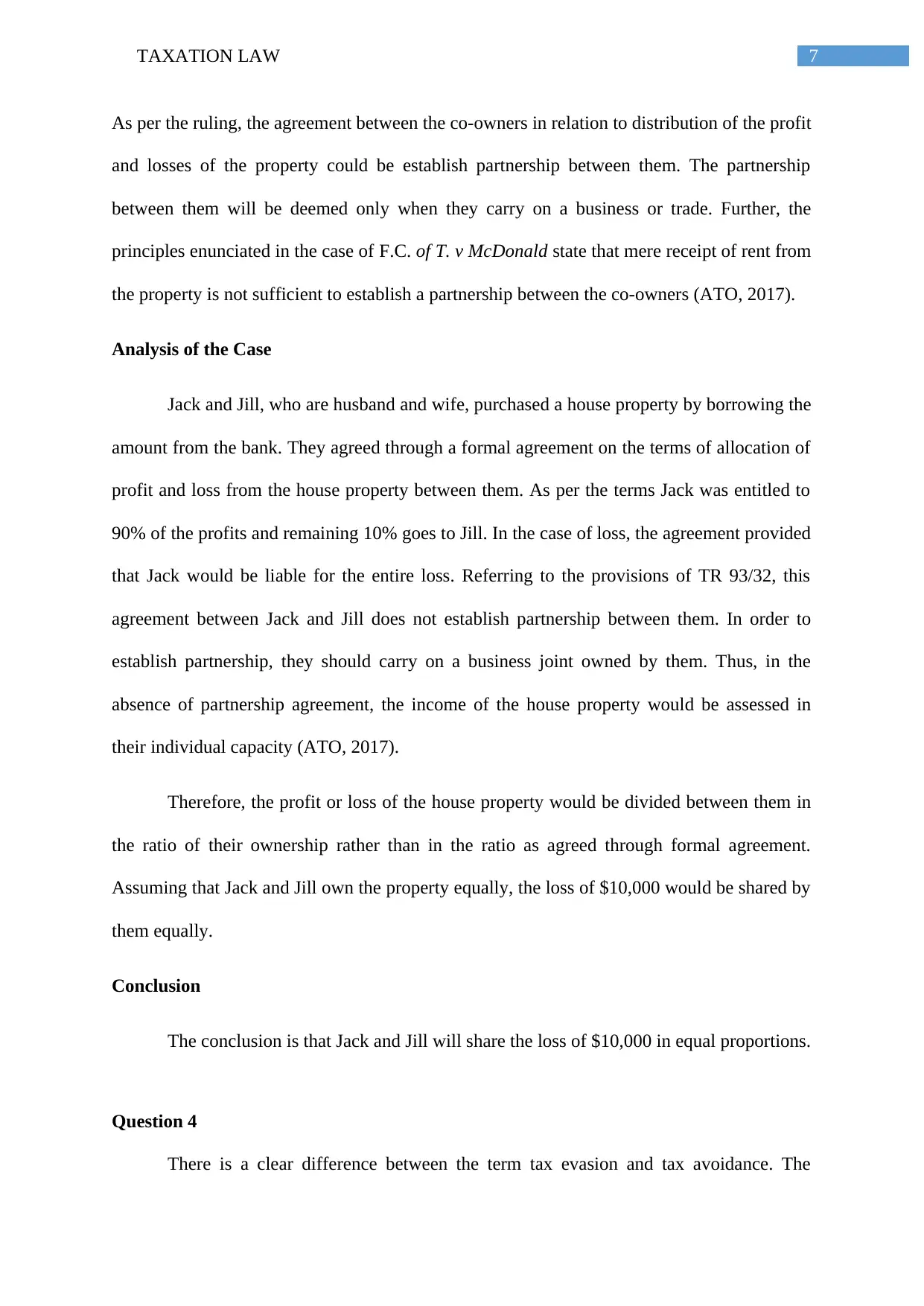
7TAXATION LAW
As per the ruling, the agreement between the co-owners in relation to distribution of the profit
and losses of the property could be establish partnership between them. The partnership
between them will be deemed only when they carry on a business or trade. Further, the
principles enunciated in the case of F.C. of T. v McDonald state that mere receipt of rent from
the property is not sufficient to establish a partnership between the co-owners (ATO, 2017).
Analysis of the Case
Jack and Jill, who are husband and wife, purchased a house property by borrowing the
amount from the bank. They agreed through a formal agreement on the terms of allocation of
profit and loss from the house property between them. As per the terms Jack was entitled to
90% of the profits and remaining 10% goes to Jill. In the case of loss, the agreement provided
that Jack would be liable for the entire loss. Referring to the provisions of TR 93/32, this
agreement between Jack and Jill does not establish partnership between them. In order to
establish partnership, they should carry on a business joint owned by them. Thus, in the
absence of partnership agreement, the income of the house property would be assessed in
their individual capacity (ATO, 2017).
Therefore, the profit or loss of the house property would be divided between them in
the ratio of their ownership rather than in the ratio as agreed through formal agreement.
Assuming that Jack and Jill own the property equally, the loss of $10,000 would be shared by
them equally.
Conclusion
The conclusion is that Jack and Jill will share the loss of $10,000 in equal proportions.
Question 4
There is a clear difference between the term tax evasion and tax avoidance. The
As per the ruling, the agreement between the co-owners in relation to distribution of the profit
and losses of the property could be establish partnership between them. The partnership
between them will be deemed only when they carry on a business or trade. Further, the
principles enunciated in the case of F.C. of T. v McDonald state that mere receipt of rent from
the property is not sufficient to establish a partnership between the co-owners (ATO, 2017).
Analysis of the Case
Jack and Jill, who are husband and wife, purchased a house property by borrowing the
amount from the bank. They agreed through a formal agreement on the terms of allocation of
profit and loss from the house property between them. As per the terms Jack was entitled to
90% of the profits and remaining 10% goes to Jill. In the case of loss, the agreement provided
that Jack would be liable for the entire loss. Referring to the provisions of TR 93/32, this
agreement between Jack and Jill does not establish partnership between them. In order to
establish partnership, they should carry on a business joint owned by them. Thus, in the
absence of partnership agreement, the income of the house property would be assessed in
their individual capacity (ATO, 2017).
Therefore, the profit or loss of the house property would be divided between them in
the ratio of their ownership rather than in the ratio as agreed through formal agreement.
Assuming that Jack and Jill own the property equally, the loss of $10,000 would be shared by
them equally.
Conclusion
The conclusion is that Jack and Jill will share the loss of $10,000 in equal proportions.
Question 4
There is a clear difference between the term tax evasion and tax avoidance. The
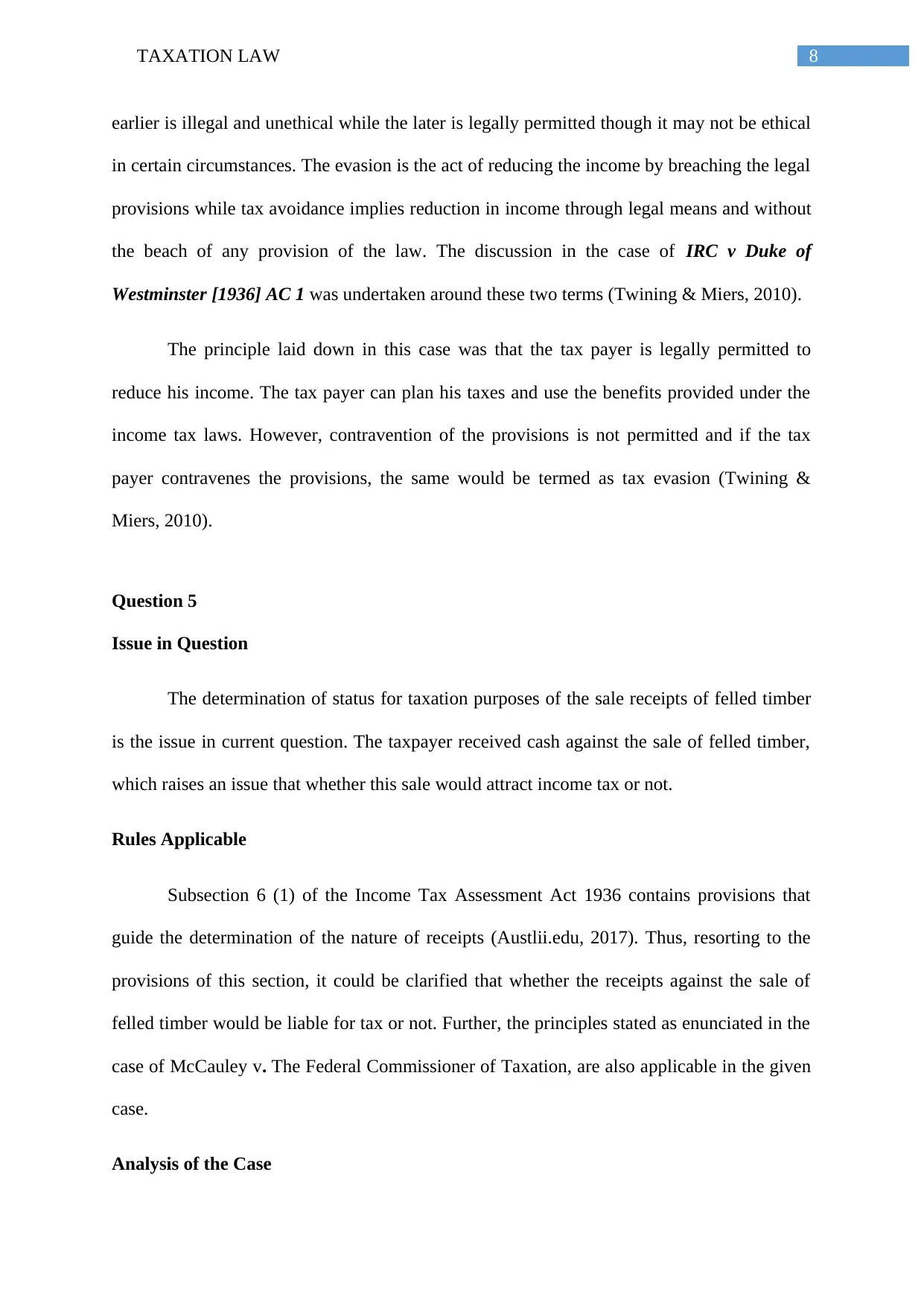
8TAXATION LAW
earlier is illegal and unethical while the later is legally permitted though it may not be ethical
in certain circumstances. The evasion is the act of reducing the income by breaching the legal
provisions while tax avoidance implies reduction in income through legal means and without
the beach of any provision of the law. The discussion in the case of IRC v Duke of
Westminster [1936] AC 1 was undertaken around these two terms (Twining & Miers, 2010).
The principle laid down in this case was that the tax payer is legally permitted to
reduce his income. The tax payer can plan his taxes and use the benefits provided under the
income tax laws. However, contravention of the provisions is not permitted and if the tax
payer contravenes the provisions, the same would be termed as tax evasion (Twining &
Miers, 2010).
Question 5
Issue in Question
The determination of status for taxation purposes of the sale receipts of felled timber
is the issue in current question. The taxpayer received cash against the sale of felled timber,
which raises an issue that whether this sale would attract income tax or not.
Rules Applicable
Subsection 6 (1) of the Income Tax Assessment Act 1936 contains provisions that
guide the determination of the nature of receipts (Austlii.edu, 2017). Thus, resorting to the
provisions of this section, it could be clarified that whether the receipts against the sale of
felled timber would be liable for tax or not. Further, the principles stated as enunciated in the
case of McCauley v. The Federal Commissioner of Taxation, are also applicable in the given
case.
Analysis of the Case
earlier is illegal and unethical while the later is legally permitted though it may not be ethical
in certain circumstances. The evasion is the act of reducing the income by breaching the legal
provisions while tax avoidance implies reduction in income through legal means and without
the beach of any provision of the law. The discussion in the case of IRC v Duke of
Westminster [1936] AC 1 was undertaken around these two terms (Twining & Miers, 2010).
The principle laid down in this case was that the tax payer is legally permitted to
reduce his income. The tax payer can plan his taxes and use the benefits provided under the
income tax laws. However, contravention of the provisions is not permitted and if the tax
payer contravenes the provisions, the same would be termed as tax evasion (Twining &
Miers, 2010).
Question 5
Issue in Question
The determination of status for taxation purposes of the sale receipts of felled timber
is the issue in current question. The taxpayer received cash against the sale of felled timber,
which raises an issue that whether this sale would attract income tax or not.
Rules Applicable
Subsection 6 (1) of the Income Tax Assessment Act 1936 contains provisions that
guide the determination of the nature of receipts (Austlii.edu, 2017). Thus, resorting to the
provisions of this section, it could be clarified that whether the receipts against the sale of
felled timber would be liable for tax or not. Further, the principles stated as enunciated in the
case of McCauley v. The Federal Commissioner of Taxation, are also applicable in the given
case.
Analysis of the Case
⊘ This is a preview!⊘
Do you want full access?
Subscribe today to unlock all pages.

Trusted by 1+ million students worldwide
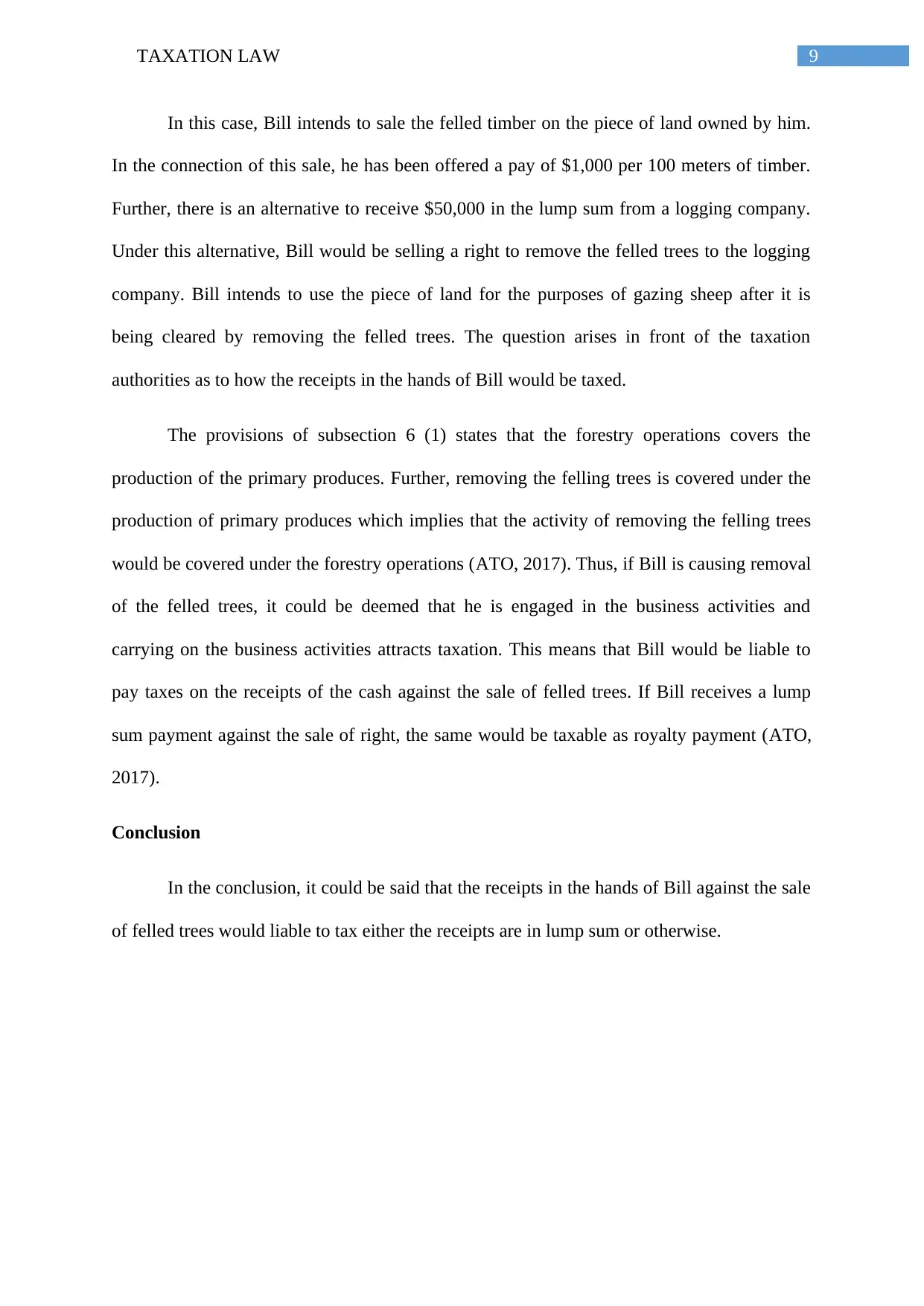
9TAXATION LAW
In this case, Bill intends to sale the felled timber on the piece of land owned by him.
In the connection of this sale, he has been offered a pay of $1,000 per 100 meters of timber.
Further, there is an alternative to receive $50,000 in the lump sum from a logging company.
Under this alternative, Bill would be selling a right to remove the felled trees to the logging
company. Bill intends to use the piece of land for the purposes of gazing sheep after it is
being cleared by removing the felled trees. The question arises in front of the taxation
authorities as to how the receipts in the hands of Bill would be taxed.
The provisions of subsection 6 (1) states that the forestry operations covers the
production of the primary produces. Further, removing the felling trees is covered under the
production of primary produces which implies that the activity of removing the felling trees
would be covered under the forestry operations (ATO, 2017). Thus, if Bill is causing removal
of the felled trees, it could be deemed that he is engaged in the business activities and
carrying on the business activities attracts taxation. This means that Bill would be liable to
pay taxes on the receipts of the cash against the sale of felled trees. If Bill receives a lump
sum payment against the sale of right, the same would be taxable as royalty payment (ATO,
2017).
Conclusion
In the conclusion, it could be said that the receipts in the hands of Bill against the sale
of felled trees would liable to tax either the receipts are in lump sum or otherwise.
In this case, Bill intends to sale the felled timber on the piece of land owned by him.
In the connection of this sale, he has been offered a pay of $1,000 per 100 meters of timber.
Further, there is an alternative to receive $50,000 in the lump sum from a logging company.
Under this alternative, Bill would be selling a right to remove the felled trees to the logging
company. Bill intends to use the piece of land for the purposes of gazing sheep after it is
being cleared by removing the felled trees. The question arises in front of the taxation
authorities as to how the receipts in the hands of Bill would be taxed.
The provisions of subsection 6 (1) states that the forestry operations covers the
production of the primary produces. Further, removing the felling trees is covered under the
production of primary produces which implies that the activity of removing the felling trees
would be covered under the forestry operations (ATO, 2017). Thus, if Bill is causing removal
of the felled trees, it could be deemed that he is engaged in the business activities and
carrying on the business activities attracts taxation. This means that Bill would be liable to
pay taxes on the receipts of the cash against the sale of felled trees. If Bill receives a lump
sum payment against the sale of right, the same would be taxable as royalty payment (ATO,
2017).
Conclusion
In the conclusion, it could be said that the receipts in the hands of Bill against the sale
of felled trees would liable to tax either the receipts are in lump sum or otherwise.
Paraphrase This Document
Need a fresh take? Get an instant paraphrase of this document with our AI Paraphraser
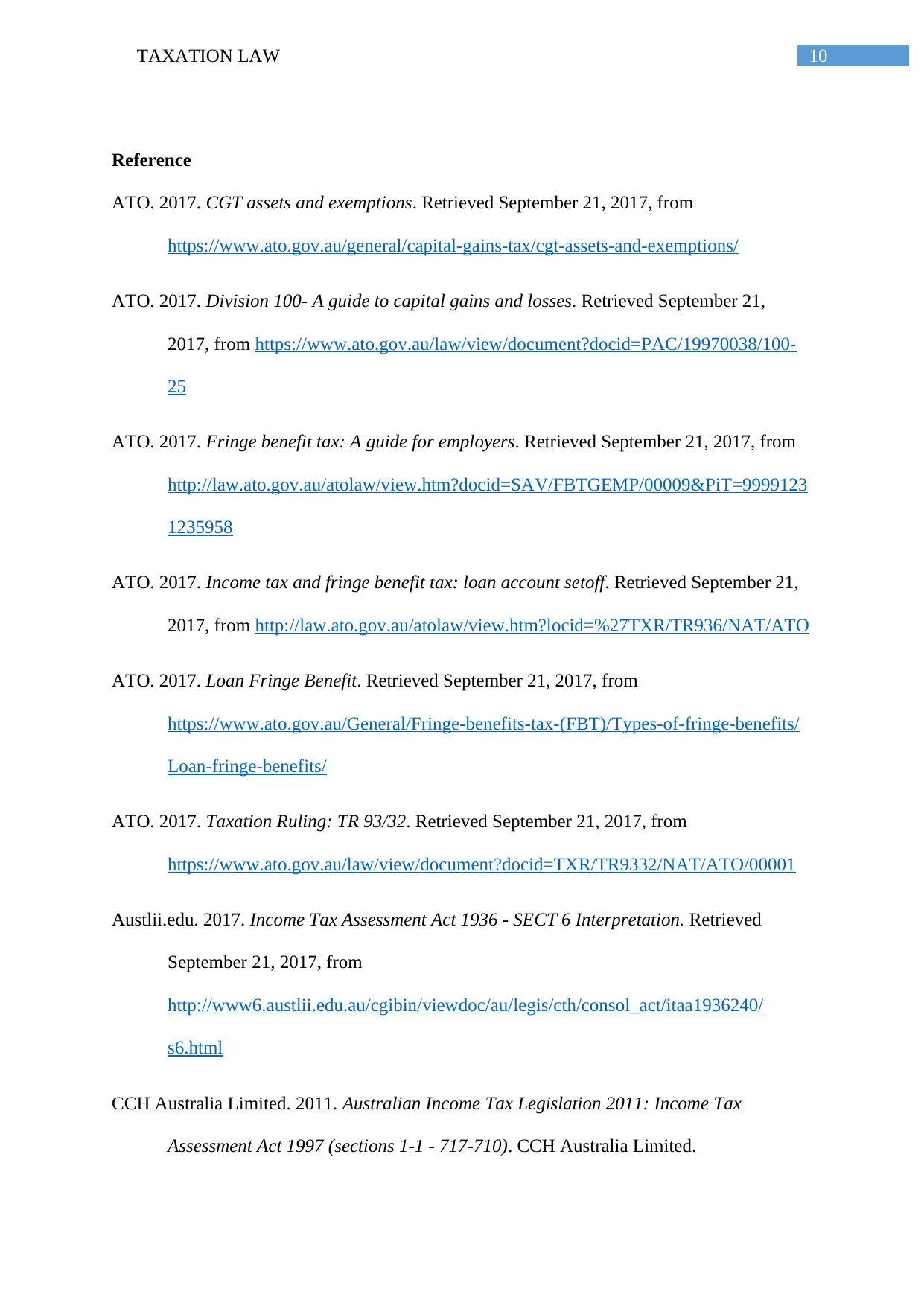
10TAXATION LAW
Reference
ATO. 2017. CGT assets and exemptions. Retrieved September 21, 2017, from
https://www.ato.gov.au/general/capital-gains-tax/cgt-assets-and-exemptions/
ATO. 2017. Division 100- A guide to capital gains and losses. Retrieved September 21,
2017, from https://www.ato.gov.au/law/view/document?docid=PAC/19970038/100-
25
ATO. 2017. Fringe benefit tax: A guide for employers. Retrieved September 21, 2017, from
http://law.ato.gov.au/atolaw/view.htm?docid=SAV/FBTGEMP/00009&PiT=9999123
1235958
ATO. 2017. Income tax and fringe benefit tax: loan account setoff. Retrieved September 21,
2017, from http://law.ato.gov.au/atolaw/view.htm?locid=%27TXR/TR936/NAT/ATO
ATO. 2017. Loan Fringe Benefit. Retrieved September 21, 2017, from
https://www.ato.gov.au/General/Fringe-benefits-tax-(FBT)/Types-of-fringe-benefits/
Loan-fringe-benefits/
ATO. 2017. Taxation Ruling: TR 93/32. Retrieved September 21, 2017, from
https://www.ato.gov.au/law/view/document?docid=TXR/TR9332/NAT/ATO/00001
Austlii.edu. 2017. Income Tax Assessment Act 1936 - SECT 6 Interpretation. Retrieved
September 21, 2017, from
http://www6.austlii.edu.au/cgibin/viewdoc/au/legis/cth/consol_act/itaa1936240/
s6.html
CCH Australia Limited. 2011. Australian Income Tax Legislation 2011: Income Tax
Assessment Act 1997 (sections 1-1 - 717-710). CCH Australia Limited.
Reference
ATO. 2017. CGT assets and exemptions. Retrieved September 21, 2017, from
https://www.ato.gov.au/general/capital-gains-tax/cgt-assets-and-exemptions/
ATO. 2017. Division 100- A guide to capital gains and losses. Retrieved September 21,
2017, from https://www.ato.gov.au/law/view/document?docid=PAC/19970038/100-
25
ATO. 2017. Fringe benefit tax: A guide for employers. Retrieved September 21, 2017, from
http://law.ato.gov.au/atolaw/view.htm?docid=SAV/FBTGEMP/00009&PiT=9999123
1235958
ATO. 2017. Income tax and fringe benefit tax: loan account setoff. Retrieved September 21,
2017, from http://law.ato.gov.au/atolaw/view.htm?locid=%27TXR/TR936/NAT/ATO
ATO. 2017. Loan Fringe Benefit. Retrieved September 21, 2017, from
https://www.ato.gov.au/General/Fringe-benefits-tax-(FBT)/Types-of-fringe-benefits/
Loan-fringe-benefits/
ATO. 2017. Taxation Ruling: TR 93/32. Retrieved September 21, 2017, from
https://www.ato.gov.au/law/view/document?docid=TXR/TR9332/NAT/ATO/00001
Austlii.edu. 2017. Income Tax Assessment Act 1936 - SECT 6 Interpretation. Retrieved
September 21, 2017, from
http://www6.austlii.edu.au/cgibin/viewdoc/au/legis/cth/consol_act/itaa1936240/
s6.html
CCH Australia Limited. 2011. Australian Income Tax Legislation 2011: Income Tax
Assessment Act 1997 (sections 1-1 - 717-710). CCH Australia Limited.
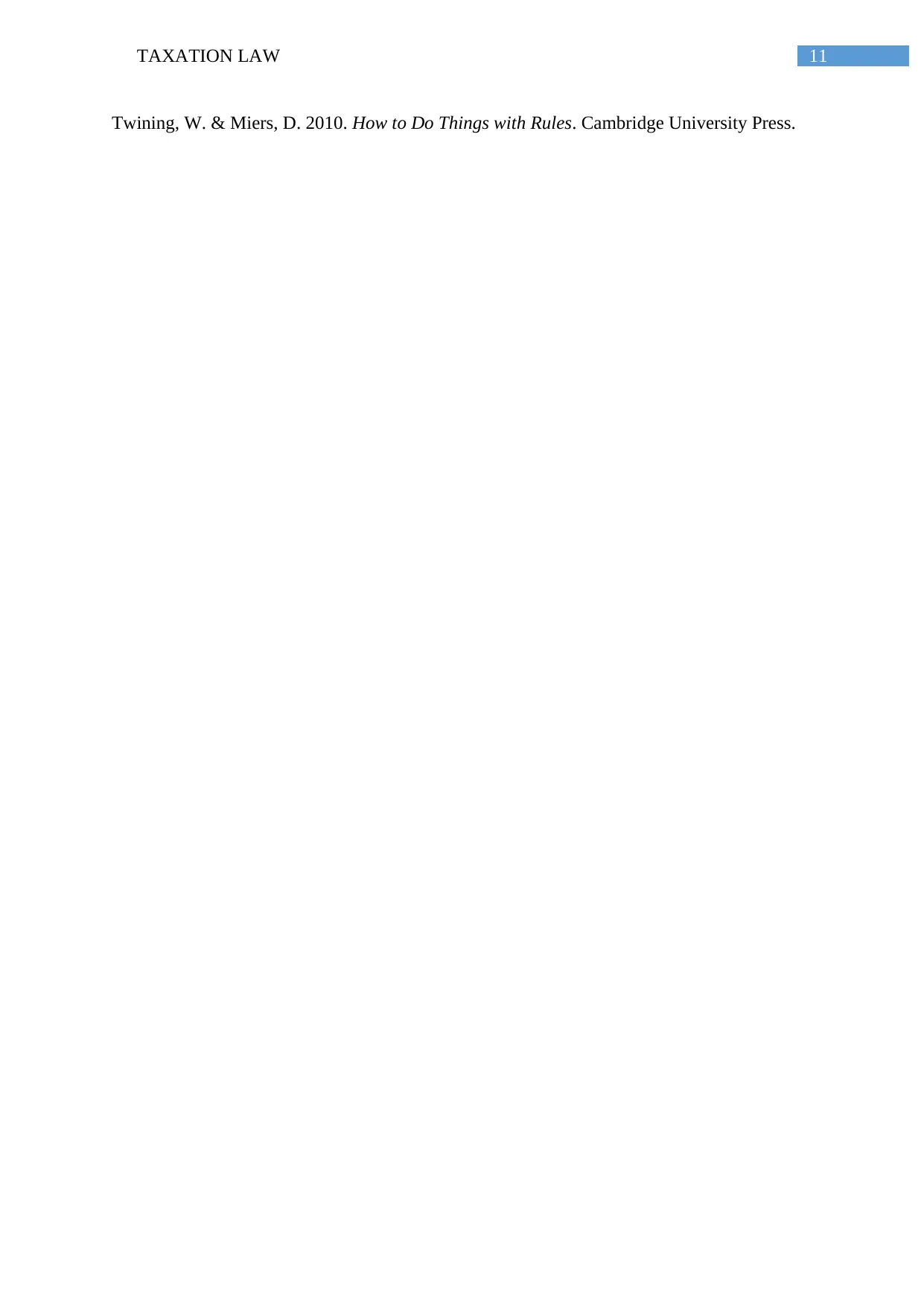
11TAXATION LAW
Twining, W. & Miers, D. 2010. How to Do Things with Rules. Cambridge University Press.
Twining, W. & Miers, D. 2010. How to Do Things with Rules. Cambridge University Press.
⊘ This is a preview!⊘
Do you want full access?
Subscribe today to unlock all pages.

Trusted by 1+ million students worldwide
1 out of 12
Related Documents
Your All-in-One AI-Powered Toolkit for Academic Success.
+13062052269
info@desklib.com
Available 24*7 on WhatsApp / Email
![[object Object]](/_next/static/media/star-bottom.7253800d.svg)
Unlock your academic potential
Copyright © 2020–2025 A2Z Services. All Rights Reserved. Developed and managed by ZUCOL.





